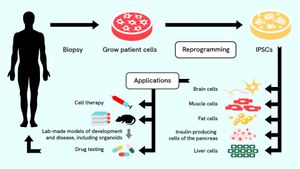MethylBERT, a novel Transformer-based model, is making waves in the domain of cancer diagnostics by enhancing the precision of read-level DNA methylation analysis. Researchers have long recognized DNA methylation (DNAm) as a key epigenetic modification with significant alterations observed in cancer cells. These modifications can offer insights not only about tumor purity but also about tumor characterization, which is pivotal for effective treatment strategies.
Current methods of analyzing DNA methylation often rely on beta-values derived from microarrays, but these approaches fall short of utilizing the comprehensive data sequencing offers. Standard sequencing techniques yield high-quality data with broad genomic coverage, preserving single-molecule signals characteristic of rare cell populations. To address the limitations of existing analytical methods, the team behind MethylBERT proposed this new model to capitalize on the vast potential of sequencing data.
"MethylBERT outperforms existing deconvolution methods and demonstrates high accuracy regardless of methylation pattern complexity, read length and read coverage," said the authors of the article. This deep learning method enables the classification of sequence reads as either tumor or normal based on distinct methylation patterns, providing accurate tumor cell fraction estimations from bulk samples, which is key for assessing tumor purity.
MethylBERT is built on the foundation of the Bidirectional Encoder Representations from Transformers (BERT) architecture, which has revolutionized various fields through its advanced processing of sequential data. The model initially undergoes pre-training with reference genomes to learn general sequence patterns before being fine-tuned for specific methylation analysis tasks. This layered approach ensures MethylBERT effectively classifies complex read-level methylation patterns.
The research emphasizes the model’s capability to classify reads with complex methylation signals. "The application of Transformers has been overlooked in sequencing-based tumor purity estimation," the authors remark, underscoring MethylBERT's innovative approach. By employing Bayesian probability inversion, it calculates the likelihood of each read's origin, allowing researchers to infer tumor cellularity with remarkable accuracy.
Results from extensive evaluations reveal MethylBERT's superiority over previous methodologies, like CancerDetector and DISMIR, particularly when faced with varied read coverage and complexity. The robustness of MethylBERT is evident across simulated scenarios, retaining accuracy even with reduced read coverage. This aspect is remarkably valuable as low concentration circulating tumor DNA (ctDNA) samples are often challenging to analyze yet contain significant diagnostic potential.
The authors' findings extend beyond traditional tumor analyses, highlighting MethylBERT's applicability to the analysis of liquid biopsy samples. This non-invasive approach could facilitate early cancer detection, improving clinical outcomes significantly. For example, as shown through targeted analyses on colorectal cancer (CRC) and pancreatic cancer (PDAC) samples, MethylBERT successfully discerns tumor purity levels across various stages of these malignancies.
"We show its applicability to cell-type deconvolution as well as non-invasive early cancer diagnostics using liquid biopsy samples," the authors concluded. This pivotal advancement may provide necessary tools for clinicians to tailor cancer treatment strategies more effectively and potentially detect malignancies at earlier stages when they are more treatable.
MethylBERT stands as a monumental leap forward for cancer research. Its ability to accurately classify cell types based on complex methylation patterns may extend utility to various non-cancerous conditions, demonstrating its versatility. The researchers hope to refine the model's efficiency, offering enhanced precision and faster analyses, particularly for clinical applications.
With the continued advancements facilitated by MethylBERT, there lies great potential for revolutionizing how methylation patterns inform cancer diagnostics and therapeutics, helping to turn the tide against these formidable diseases.



